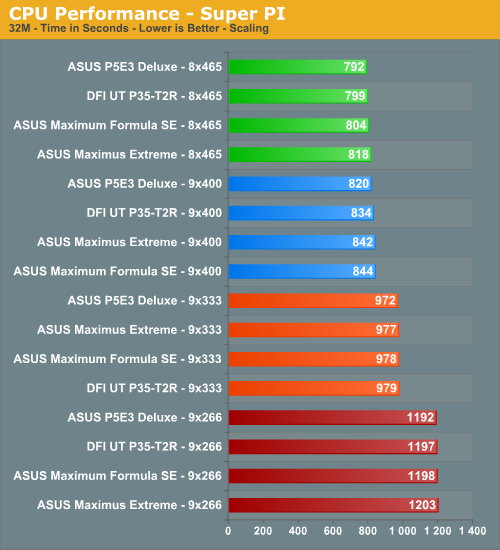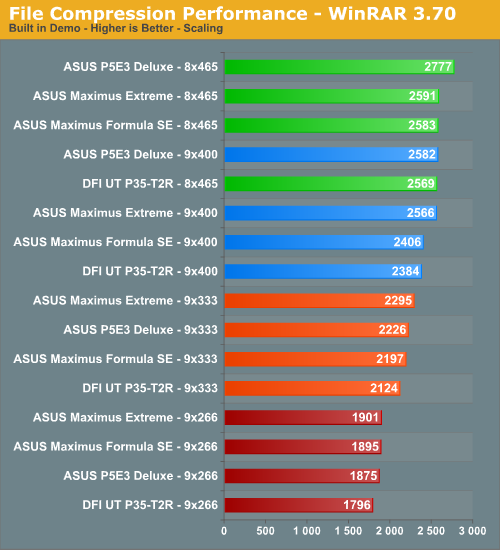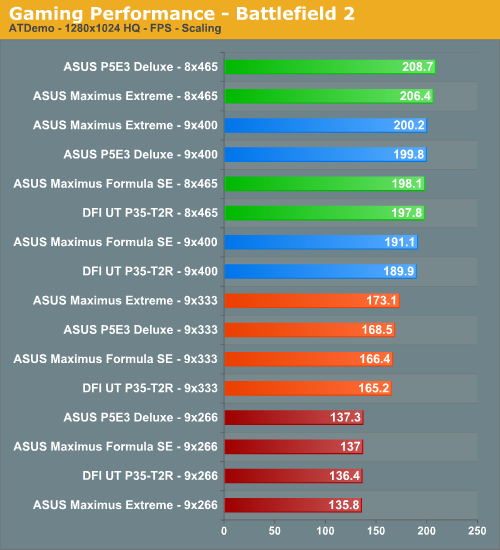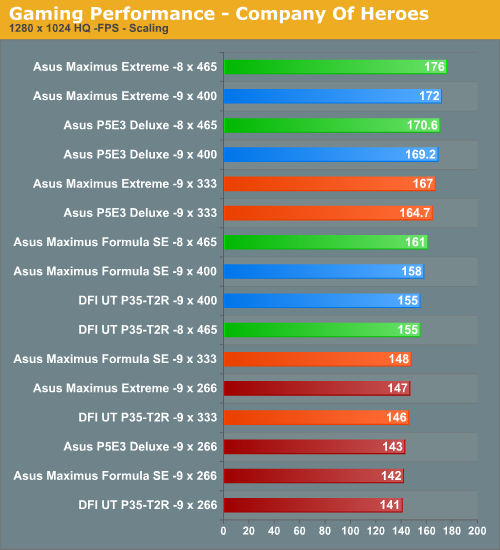ASUS Maximus Extreme - the Extreme Benchmarker's Choice?
by Rajinder Gill on December 10, 2007 8:00 AM EST- Posted in
- Motherboards
XP Overclocking Benchmarks






Thoughts on basic overclocking
The Maximus Extreme fares well in all our 3D based tests. Obviously, the performance gains are not huge, as you never get double the performance for double the price. Results between the P5E3 Deluxe and the Maximus Extreme are tight, so choosing either board for a daily system is not going to offer significant advantages at this level of overclocking. Benchmarks such as Super Pi 32M really benefit from very tight secondary RAM timings - often far beyond the capabilities of complete system stability - so take the largely un-tuned results here with a pinch of salt. The board is stable up to around 465 FSB with 65nm quad processors. For those who are interested in Folding@Home, 450 FSB is the real limit.
Although not shown here, we did run some Vista based stability testing with 4GB of memory. Results were very promising: full 4GB stability at DDR3 1700-1800 with 1N command rate also came in around 445-450FSB. Users who buy this board with 24/7 use in mind will generally be avid gamers. For this purpose, the X38 boards are marginally faster than their P35 based counterparts are. Also remember, with X38 boards the option of dual - or in this case triple - graphics cards can provide a level of future proofing. Especially as gaming engines are becoming more complex, dual GPUs will be necessary to play games at high-res with maximum detail settings for the near future.
If the sole reason for choosing this board is the additional DDR3 performance gains (albeit small), then top-end DDR3-1800 modules will be necessary to realize any benefits. At speeds below DDR3-1600 to DDR3-1333, CA 6 to CAS5 performance with DDR3 will show results close to DDR2-1150 at CAS5. If you prefer dual graphics cards without the added expenditure hit of DDR3 memory, there are a couple of DDR2 X38 boards to chose from. The ASUS Maximus Formula fills the role admirably for more advanced overclockers or the Gigabyte GA-X38-DQ6 is a nice alternative.










27 Comments
View All Comments
markglh - Sunday, January 13, 2008 - link
Does the Thermalright Ultra-120 Extremem fit ok on this motherboard in a position so that it blows air out of the case? I was worried that the fusion waterblock and the heatsink at the top of the board might be too tall.thanks.
astronaute - Wednesday, December 26, 2007 - link
Can someone explain please why in BIOS screenshots we can see FSB 400 and QX6600 FSB is more then 1000 ?Sorry if my question is stupid :)
Rajinder Gill - Sunday, December 30, 2007 - link
The BIOS screenshots shown are provided only to illustrate which BIOS functions are available for the user. They have no direct correlation whatsoever with a Q6600 or it's FSB.regards
Raja
qquizz - Thursday, December 13, 2007 - link
With a name like Maximus Extreme the board better be one bad mofo, err... i mean mobo.Zak - Monday, December 10, 2007 - link
Something's not right, C2D Extreme and 8800Ultra??? I get over 12000 in 3D Mark 2006 with a $99 Gigabyte mobo, 3GHz C2D @3.8Ghz with Tuniq Tower, 800MHz DDR2 and 8800GTX slightly overclocked.Z.
Azured - Monday, December 10, 2007 - link
No that seems allright. The test is run with a Q6600 (actually a QX6850 with a lower multiplier to simulate the Q6600) at stock 2.4GHz. considerably slower than your C2D at 3.8GHz.Zak - Monday, December 10, 2007 - link
Oh, I must have misread something then, thanks:)Z.
takumsawsherman - Monday, December 10, 2007 - link
Now this blows me away. $350 and still no Firewire800! How much money should you have to pay before you get a feature that was commercially introduced 4 years ago. Instead, you get the slower variant that first saw real action 8 years ago. What's next, USB 1.1?Maybe I didn't read the Newegg price tag correctly, but if I did, this is a travesty. And of course, no room for a PS/2 mouse port. I mean, a single PS/2 port, in a non-standard position. At first, it may seem to be no big deal, but why make it different that almost every other config? So when muscle-memory leads you blindy around the back of the case when you install a keyboard, you have to hunt around more. Not to mention that most PS/2 devices are pretty static in that people aren't switching them all the time. USB, on the other hand, is more frequently connected and disconnected. Having the PS/2 keyboard plugged in gives you limited room to change USB stuff, especially if you have another USB device plugged in. If the PS/2 port was on the bottom, you can stack a USB connector on top and still have finger room to add or remove another, without risking disconnection of another cable (PS/2 for example).
A ridiculous board, at a ridiculous price.
retrospooty - Monday, December 10, 2007 - link
not to burst your bubble but, Firewire 800 is never going to take off. Before it got started it was surpassed and totally obsoleted by eSATA. You wont ever see it as a standard feature on even high end motherboards. If you have use for it, you need to by an adaptor card for it.Etern205 - Monday, December 10, 2007 - link
Yes, eSATA is faster than Firewire 800 which is why eSATA is gaining popularity than Fire800. As for only 1 PS/2 port, if those articles or rumors are correct, then by the time ICH10 comes out we'll not see anymore PS/2 ports or PCI slots.In a question unrelated to this article, for those of you that have a usb wireless mouse or keyboard are you able to switch between the OSes if you guy have a dual or mult-boot system?
Thanks!